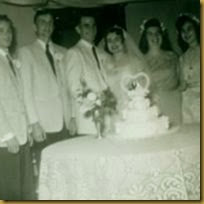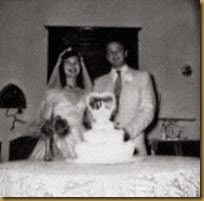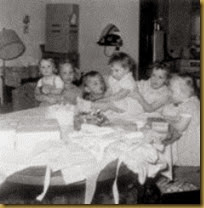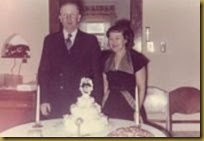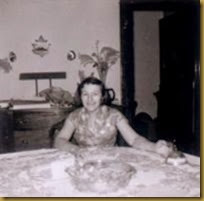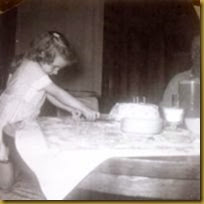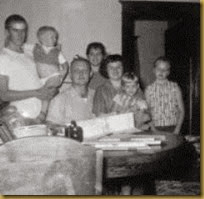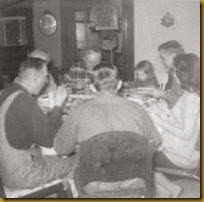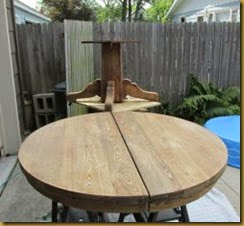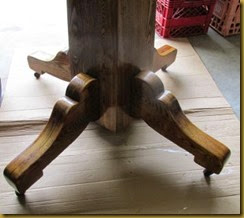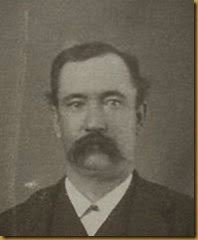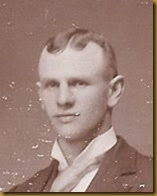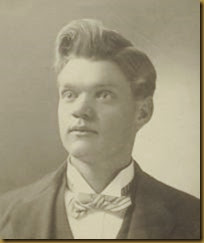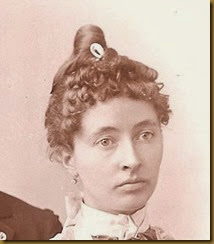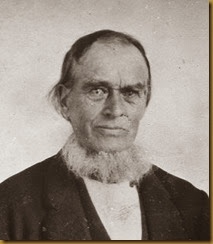It was 24 years ago today that my grandmother passed away.
I don't spend much time thinking about that day anymore, but I love the memories she left with me. She was no ordinary grandma.
She traumatized me with Dippity-do, poisoned me with her Green Drops medicine, almost ruined me for wanting children with the Ugly Baby, and totally "bamboozled" us with her tall tales of dying from pimples, getting our eyes pecked out from pet birds, and the terrible, terrible things the doctor would have to do if we got constipated.
She taught me Guppy Genetics, how to feed anyone anything using meatloaf, the art of making a sewing pattern out of newspaper, and playing the piano chords of the old 1940s dance music while she played the melodies.
She was fun - we had things at her house that we didn't get at home, like treasure boxes, the Family Doghouse, homemade picture books, sea shells, and party hats and noisemakers. And she let us play with glitter. That never, ever happened at home. Ever.
She had her idiosyncrasies. She loved her grandchildren, but would lock us outside in a heartbeat when As The World Turns came on. She "flowered-over" ex-spouses and boyfriends, no questions asked.
She kept secrets well and bent over backwards to cover peoples' faults. She rarely had an unkind word to say about anyone, but if someone said something bad about one of us, they'd better watch it. If it wasn't true, she'd set them straight in no uncertain terms, and if it was true, she'd tell them to mind their own business, in a very polite way, of course.
Even after 24 years, it doesn't feel as though she's gone. I feel her presence every evening when we have dinner at her table, serve something in the pink bowl, when I'm in my sewing room, watching the bird feeder and telling stories about her to my young granddaughters. So this day, it's her living I will remember.

Thursday, March 5, 2015
Saturday, February 21, 2015
KGDY - Huron's "Voice of South Dakota"
87 years ago, in the back room of a small town pharmacy, Huron, South Dakota's first radio station took root. It was KGDY; the year was 1928, and the place was Oldham, South Dakota. The station, operated by J. Alfred Loesch, and bankrolled by John and William Loesch, was started not only as a public service, but also to promote the sales of radio receivers, which were sold by the Loesch family's pharmacy. Their broadcast day ran from 2 - 6 pm, unless there was a local basketball game; and then William Loesch covered the "home" games, and Lou Loesch called the "away" games. Other programming included local talent, and lots of polka music. And one lone advertiser - the pharmacy.
The station experienced its first growth in 1929 when it applied for a 6-fold increase in power, from 15 watts to 100 watts, and for permission to move the station to Huron. The Federal Radio Commission granted that request in March of the following year, and assigned the station to operate on 1200 kilocycles. However, the approval was not easily won, as South Dakota was already over its power quota, but Rep. A. C. Christopherson of Sioux Falls intervened on behalf of the station. The extra wattage was estimated to result in good reception for 200-300 miles.
The work of moving the station began, with a formal opening planned for August 1, 1930, with engineer Alfred T. Nelson of Oldham coming to Huron as the chief engineer. J. Albert Loesch was the president of the new company, the "Voice of South Dakota." Dual 80' towers were erected 3 miles north of Huron, just south of the Huron Country Club, and a studio was set up downtown, above the Golden Rule store. The book "Huron Revisited" lists the location to be the upper level of 351 Dakota, and the local newspaper gives the address as 345 Dakota S., but city directories give the address of 347 Dakota S., above the Wright Land Company, which sat next door to the Golden Rule store, and probably shared the building.
The new studio included a 50 seat auditorium with a glass wall separating the audience from the broadcast area; within the broadcast area was a glass booth for the announcer. The cost for the studio and the towers was $14,000. The station operated on 100 watts of power, but that amount could be stepped up to 500 watts on short notice. Despite the increase in power, the company reiterated that this new station would not interfere with others that Huron residents enjoyed hearing. KGDY would be located on the radio dial near KSOO of Sioux Falls.
The formal opening of the station was slightly delayed from August 1 to August 29, but a large celebration was planned to commemorate the event. The broadcast day would run from 7 a.m. until "late at night," and the first day would feature not only prominent speakers, but local musical talent. Among the speakers were Dean C. Larsen of the State College; Frank D. Kriebs, S. D. State Secretary of Agriculture; U. S. congressman Royal C. Johnson, and Huron mayor E. T. Gitchell.
Among the musical artists taking part were Mrs. C. E. Coyne, Mrs. R. W. Gibson, Mrs. Genevieve Trask, Miss Lois Gitchell, Beryl Kinkead-Stratton, Robert Bryan, Mrs. Max Royal, Winnifred Brewer of Woonsocket, the Huron College String Ensemble, D. J. O'Connor the "one armed fiddler of Miller," Phylis and Junior Boughman of Highmore, several dance and old-time orchestras, as well as Eddie and Jimmie Dean, the famous Coffey Boys, who were billed as "the most popular radio entertainers in the northwest."
Community excitement was high, as evidenced by the number of flower bouquets, telegrams, and telephone calls received.
The radio station was even used as an alibi in a bank robbery, when suspect Ed "Hungry Slim" Vandiver claimed to be singing on KGDY when the Merchants National Bank of Hatton, N.D. was robbed on September 14, 1932; however, no corroborating record of his performance on KGDY was found.
In March of 1933, the station was granted another increase in power from 100 watts to 250 watts. George W. Wright, then president of Voice of South Dakota, said the station would need to go off the air for four weeks while the improvements were being implemented. The station would be changed to a regional channel at 1340 kilocycles, and a mid-April re-opening was anticipated.
Unfortunately, just days later, fire broke out in the KGDY studio, resulting in heavy damage in both the studio and the Golden Rule store below it. The store stocked ready-to-wear women's clothing, and both inventory and fixtures were heavily damaged by smoke and water. The store carried insurance adequate to cover the losses. It was a different scenario with the radio station, however. The studio equipment was completely destroyed - a $2500 loss. Insurance coverage amounted to $1,000. In addition, the building sustained roof and wall damage. The cause of the fire was never determined.
The station was then sold to the Greater Kampeska Radio corporation of Watertown, and Robert J. Dean was appointed station manager. The station had not broadcast since the fire five months earlier. It was anticipated that the station would "open soon."
The last signoff of KGDY occurred in 1936, and was witnessed by G. W. Chitty. That summer, Chitty learned that the station was up for sale, and he came with an interest in making the purchase. However, he was not impressed with what he found. There was still no studio in town, and the station had been broadcasting from their transmitter north of town due to problems with the local phone company. The FCC had condemned their equipment and the owners had until Feb. 1, 1937 to replace it. The station was in terrible condition - the only asset being their permit to operate. For this reason, Chitty made what he considered to be a reasonable offer, and it was refused. But the owners did agree to let him manage the station until the new equipment was installed. Chitty immediately settled the dispute with the telephone company and got the phone service restored; he then located studio space on the second floor of the old K.P. Building (later the Farmers & Merchants Bank building), and got the old equipment moved to the new space. But the FCC's deadline was nearing, and there was no sign of any progress in securing the new equipment. The owners at that time (Dr. Koren, Robert Dean, and Mark Plowman of Watertown) were impacted by the Great Depression and it is believed that a lack of funds was the chief problem.
On January 31, 1937, the federal government ordered KGDY to cease operations at the end of the day. Chitty remarked, "Huron's radio call letters were not to be heard again until June 30, 1947, when we put KIJV on the air."
Sources:
The Evening Huronite, April 22, 1929
The Evening Huronite, October 1, 1929
The Evening Huronite, March 22, 1930
The Evening Huronite, July 9, 1930
The Evening Huronite, August 23, 1930
The Evening Huronite, August 27, 1930
The Evening Huronite, August 29, 1930
The Evening Huronite, December 9, 1932
The Evening Huronite, March 15, 1933
The Evening Huronite, March 20, 1933
The Evening Huronite, August 8, 1933
The Evening Huronite, November 9, 1933
The Evening Huronite, July 1, 1936
The Evening Huronite, October 8, 1936
The Evening Huronite, March 16, 1937
The Evening Huronite, May 31, 1937
The Evening Huronite, December 10, 1937
The Daily Plainsman, Dec. 15, 1972
The Daily Plainsman, January 5, 1973
Google Earth
"Huron Revisited"
The station experienced its first growth in 1929 when it applied for a 6-fold increase in power, from 15 watts to 100 watts, and for permission to move the station to Huron. The Federal Radio Commission granted that request in March of the following year, and assigned the station to operate on 1200 kilocycles. However, the approval was not easily won, as South Dakota was already over its power quota, but Rep. A. C. Christopherson of Sioux Falls intervened on behalf of the station. The extra wattage was estimated to result in good reception for 200-300 miles.
The work of moving the station began, with a formal opening planned for August 1, 1930, with engineer Alfred T. Nelson of Oldham coming to Huron as the chief engineer. J. Albert Loesch was the president of the new company, the "Voice of South Dakota." Dual 80' towers were erected 3 miles north of Huron, just south of the Huron Country Club, and a studio was set up downtown, above the Golden Rule store. The book "Huron Revisited" lists the location to be the upper level of 351 Dakota, and the local newspaper gives the address as 345 Dakota S., but city directories give the address of 347 Dakota S., above the Wright Land Company, which sat next door to the Golden Rule store, and probably shared the building.
*****
*****
The formal opening of the station was slightly delayed from August 1 to August 29, but a large celebration was planned to commemorate the event. The broadcast day would run from 7 a.m. until "late at night," and the first day would feature not only prominent speakers, but local musical talent. Among the speakers were Dean C. Larsen of the State College; Frank D. Kriebs, S. D. State Secretary of Agriculture; U. S. congressman Royal C. Johnson, and Huron mayor E. T. Gitchell.
Among the musical artists taking part were Mrs. C. E. Coyne, Mrs. R. W. Gibson, Mrs. Genevieve Trask, Miss Lois Gitchell, Beryl Kinkead-Stratton, Robert Bryan, Mrs. Max Royal, Winnifred Brewer of Woonsocket, the Huron College String Ensemble, D. J. O'Connor the "one armed fiddler of Miller," Phylis and Junior Boughman of Highmore, several dance and old-time orchestras, as well as Eddie and Jimmie Dean, the famous Coffey Boys, who were billed as "the most popular radio entertainers in the northwest."
Community excitement was high, as evidenced by the number of flower bouquets, telegrams, and telephone calls received.
The radio station was even used as an alibi in a bank robbery, when suspect Ed "Hungry Slim" Vandiver claimed to be singing on KGDY when the Merchants National Bank of Hatton, N.D. was robbed on September 14, 1932; however, no corroborating record of his performance on KGDY was found.
In March of 1933, the station was granted another increase in power from 100 watts to 250 watts. George W. Wright, then president of Voice of South Dakota, said the station would need to go off the air for four weeks while the improvements were being implemented. The station would be changed to a regional channel at 1340 kilocycles, and a mid-April re-opening was anticipated.
Unfortunately, just days later, fire broke out in the KGDY studio, resulting in heavy damage in both the studio and the Golden Rule store below it. The store stocked ready-to-wear women's clothing, and both inventory and fixtures were heavily damaged by smoke and water. The store carried insurance adequate to cover the losses. It was a different scenario with the radio station, however. The studio equipment was completely destroyed - a $2500 loss. Insurance coverage amounted to $1,000. In addition, the building sustained roof and wall damage. The cause of the fire was never determined.
The station was then sold to the Greater Kampeska Radio corporation of Watertown, and Robert J. Dean was appointed station manager. The station had not broadcast since the fire five months earlier. It was anticipated that the station would "open soon."
The last signoff of KGDY occurred in 1936, and was witnessed by G. W. Chitty. That summer, Chitty learned that the station was up for sale, and he came with an interest in making the purchase. However, he was not impressed with what he found. There was still no studio in town, and the station had been broadcasting from their transmitter north of town due to problems with the local phone company. The FCC had condemned their equipment and the owners had until Feb. 1, 1937 to replace it. The station was in terrible condition - the only asset being their permit to operate. For this reason, Chitty made what he considered to be a reasonable offer, and it was refused. But the owners did agree to let him manage the station until the new equipment was installed. Chitty immediately settled the dispute with the telephone company and got the phone service restored; he then located studio space on the second floor of the old K.P. Building (later the Farmers & Merchants Bank building), and got the old equipment moved to the new space. But the FCC's deadline was nearing, and there was no sign of any progress in securing the new equipment. The owners at that time (Dr. Koren, Robert Dean, and Mark Plowman of Watertown) were impacted by the Great Depression and it is believed that a lack of funds was the chief problem.
On January 31, 1937, the federal government ordered KGDY to cease operations at the end of the day. Chitty remarked, "Huron's radio call letters were not to be heard again until June 30, 1947, when we put KIJV on the air."
Sources:
The Evening Huronite, April 22, 1929
The Evening Huronite, October 1, 1929
The Evening Huronite, March 22, 1930
The Evening Huronite, July 9, 1930
The Evening Huronite, August 23, 1930
The Evening Huronite, August 27, 1930
The Evening Huronite, August 29, 1930
The Evening Huronite, December 9, 1932
The Evening Huronite, March 15, 1933
The Evening Huronite, March 20, 1933
The Evening Huronite, August 8, 1933
The Evening Huronite, November 9, 1933
The Evening Huronite, July 1, 1936
The Evening Huronite, October 8, 1936
The Evening Huronite, March 16, 1937
The Evening Huronite, May 31, 1937
The Evening Huronite, December 10, 1937
The Daily Plainsman, Dec. 15, 1972
The Daily Plainsman, January 5, 1973
Google Earth
"Huron Revisited"
Sunday, September 7, 2014
The Family Doghouse
If I were going to post about special memories of my grandparents on Grandparent's Day, I wouldn't know where to begin. There's the Ugly Baby, Grandma's adventures with Contact Paper, swiping her True Story magazines, making Christmas ornaments, my love affairs with her double boiler, serving bowl, and sewing table, the unthinkable things she used to do to my hair, and of course, the lies she told us regularly. But when Thomas MacEntee of Geneabloggers posted a photo of the old Family Doghouse, I knew I'd found my topic.
After a trip to Arizona, my grandparents came back with this gem that they'd picked up from a tourist shop in New Mexico, probably around 1970. Grandpa hung it from the kitchen wall, and the fun began. My brother, sister and I took turns putting each other in the "place of honor", getting mad at each other, and pitching fits until we discovered the perfect enemy - Grandpa! He acted so indignant about being in the dog house that we quickly forgot about each other. This lasted for quite awhile, until one rainy morning when he commented how glad he was to be in the doghouse so he wasn't getting rained on like we were. He later told me the looks on our faces was priceless, and it was probably the first time we'd ever been speechless, all three of us, at one time!
They were fantastic grandparents, and we were blessed to live so close and spend so much time with them. They were such positive influences on our lives, and a lot of fun to boot.
Sunday, August 10, 2014
The Old Table and the Wild Hair
Yesterday morning, I had my husband pull my grandparents’ old dining room table from the back of the garage, where it has been sitting for some time. I always intended to refinish it, but the fact that I don’t know the first thing about the process kept me in procrastination mode. I thought perhaps I could clean it up and put it into service again, but seeing its condition made me angry and very sad at the same time. Grandma took good care of it while she was alive, but after that it was slowly destroyed. Splatters of dried paint, and a thin coat of glue and glitter covered both the top and the beautiful ornate pedestal base. I realized that no amount of “cleaning it up” was going to make any difference. At that point, I got the Wild Hair…
Grandma originally got this table around 1957-1958, after their home on the farm burned down and they moved to town. She very rarely bought anything new, so I assume the table was second-hand when she bought it. It was the center of every important (and unimportant) event in our family for the next ~40 years.
Grandma originally got this table around 1957-1958, after their home on the farm burned down and they moved to town. She very rarely bought anything new, so I assume the table was second-hand when she bought it. It was the center of every important (and unimportant) event in our family for the next ~40 years.
It held my parents’ wedding cake…
It held my Aunt’s wedding cake…
It held a squirming 1 year old and all her presents…
It held my Grandparents’ 25th anniversary cake…
It was the centerpiece of my Grandmother’s Card Club meetings…
And more birthday cakes…
And company from far away…
New Years’ celebrations…
And so many delicious Christmas and Thanksgiving dinners were served from it.
And it holds so many other memories for which pictures only exist in my memory and in my heart… Memories which served to fuel that Wild Hair to which I referred earlier. The next thing I knew, it had been stripped and sanded -
and today, I hesitantly made a decision on the stain, and got busy -
I am hoping by this time next week, it’s sitting in my dining room ready for Generation #6 to begin making memories.
Friday, June 27, 2014
Mom!! Grandma took away my Cleavage!!
Yes, I did. I got a cute picture of my granddaughters, and one of the older ones was inadvertently (I'm hoping), showing a little more cleavage than Old Grandma thought necessary. Ten minutes with Photoshop and things are good, at least from my perspective. If I was a little better skilled with the program, it wouldn't have taken me that long, but who cares? In the end, I did what a grandma needs to do.
As I was working, I thought about my own grandmother, Lill. She was the original Photoshop Master, and she never went anywhere near a computer. Her method of choice was Contact Paper. Remember that stuff? That wonderful-but-cheesy sticky paper that you could use inside your kitchen cabinets and drawers, on tabletops, or wherever you needed a quick and cheap "makeover." What a feeling of success when installation went smoothly, and whatever you were sticking it to was totally transformed... and what a feeling of exasperation if you weren't careful and the adhesive side stuck to something it wasn't meant to.
Grandma took Contact Paper a step further. Sitting in her living room one afternoon, I saw a new picture of my cousin and her little boy hanging on the wall. The background was lovely - daisies! I remarked about what a nice picture it was, and she had me look at it closer. The daisies were covering my cousin's ex-boyfriend! Grandma had painstakingly cut out these flowers from Contact Paper and strategically placed them, and the result was actually good! Looking closer at the other photos on the wall, I noticed another where the divorced spouse had been "flowered-over." This phrase became a part of our family's legacy, as spouses were jokingly threatened with being flowered-over from that point on.
I kind of shudder when I think about what Grandma might have done with a computer and Photoshop. Ex-husbands and wives would be gone from the family photos in a millisecond; that grandson with the long, shaggy hair would gotten a respectable haircut; eye makeup would have been toned down.
And I take comfort in the fact that none of *her* granddaughters would have sported any cleavage either.
As I was working, I thought about my own grandmother, Lill. She was the original Photoshop Master, and she never went anywhere near a computer. Her method of choice was Contact Paper. Remember that stuff? That wonderful-but-cheesy sticky paper that you could use inside your kitchen cabinets and drawers, on tabletops, or wherever you needed a quick and cheap "makeover." What a feeling of success when installation went smoothly, and whatever you were sticking it to was totally transformed... and what a feeling of exasperation if you weren't careful and the adhesive side stuck to something it wasn't meant to.
Grandma took Contact Paper a step further. Sitting in her living room one afternoon, I saw a new picture of my cousin and her little boy hanging on the wall. The background was lovely - daisies! I remarked about what a nice picture it was, and she had me look at it closer. The daisies were covering my cousin's ex-boyfriend! Grandma had painstakingly cut out these flowers from Contact Paper and strategically placed them, and the result was actually good! Looking closer at the other photos on the wall, I noticed another where the divorced spouse had been "flowered-over." This phrase became a part of our family's legacy, as spouses were jokingly threatened with being flowered-over from that point on.
I kind of shudder when I think about what Grandma might have done with a computer and Photoshop. Ex-husbands and wives would be gone from the family photos in a millisecond; that grandson with the long, shaggy hair would gotten a respectable haircut; eye makeup would have been toned down.
And I take comfort in the fact that none of *her* granddaughters would have sported any cleavage either.
Friday, May 2, 2014
James Callender Adams
James Callender Adams was born 14 April 1735 (or 1737), the son of James H. Adams and his wife Sarah Callender
Prior to his marriage in 1762, he lived in Stillwater, Saratoga co., New York.
He married Submit Purchase, daughter of Jonathan Purchase and Margaret Worthington, on 27 Jan 1762 in Springfield, Hampden co., Massachusetts. Submit was born 22 Jan 1735 in Connecticut.
Between 1783 and 1786, James and Submit moved their family to St. Johnsbury, Caledonia co., Vermont, being the first settlers in that area. They loaded their boats at Springfield, Massachusetts. These boats had rafters covered with canvas and blankets to protect their belongs, which included their furniture, a large clock, a spinning wheel and loom, chests of their bedding, clothing, and provisions for the trip. They rowed upstream on the Connecicut river, to the Passumpsic River, then to the West Branch, where they stopped, thinking they were at Littleton, New Hampshire, their intended destination. They decided to stay, settling on "Benton's Meadow". His father James, and brothers Jonathan and Martin also were granted land there. It is said that they were going to Littleton because James won land in Littleton in a singing contest. The song he sang was "Brave Wolfe", written by his son Jonathan. A descendant is said to own a copy of this song in it's original handwriting.
Another descendant states that the family went from Massachusetts to Tinmouth, Vermont about 1774, when sons James, Martin and Jonathan were in the Revolutionary War, and afterwards were granted land rights in Littleton township. While Martin's Revolutionary War pension file does not mention land grants, it should be noted that he entered the service from Tinmouth and mentions his father's home there.
They built the first home, made of logs, using a mud/twig mixture for caulk, and a pine bough roof. Oiled paper covered the windows. They slept on beds of pine and spruce boughs, and bear skins provided rugs for the floor.
Not surprisingly, they also were responsible for holding the first religious services, which was their evening worship around the fire, Bible-reading, praying, and singing hymns.
Submit Adams was noted as being the first woman to keep house within the bounds of that township.
James' house in St. Johnsbury burned at some point, destroying son Martin's Revolutionary War discharge papers.
Submit died on 13 Nov 1797 at St. Johnsbury, at the age of 62. She was buried at Adams-Babcock cemetery in Waterford, Vermont. James then married Mrs. Trescott. James died in 1813 in Newport, Orleans co., Vermont, at the age of 78. He was buried on his farm in St. Johnsbury, Caledonia co., Vermont.
James and Submit Adams had six children: Martin, Jonathan, Thirza, Clarissa "Polly", James Callender, and Charles.
Prior to his marriage in 1762, he lived in Stillwater, Saratoga co., New York.
He married Submit Purchase, daughter of Jonathan Purchase and Margaret Worthington, on 27 Jan 1762 in Springfield, Hampden co., Massachusetts. Submit was born 22 Jan 1735 in Connecticut.
Between 1783 and 1786, James and Submit moved their family to St. Johnsbury, Caledonia co., Vermont, being the first settlers in that area. They loaded their boats at Springfield, Massachusetts. These boats had rafters covered with canvas and blankets to protect their belongs, which included their furniture, a large clock, a spinning wheel and loom, chests of their bedding, clothing, and provisions for the trip. They rowed upstream on the Connecicut river, to the Passumpsic River, then to the West Branch, where they stopped, thinking they were at Littleton, New Hampshire, their intended destination. They decided to stay, settling on "Benton's Meadow". His father James, and brothers Jonathan and Martin also were granted land there. It is said that they were going to Littleton because James won land in Littleton in a singing contest. The song he sang was "Brave Wolfe", written by his son Jonathan. A descendant is said to own a copy of this song in it's original handwriting.
Another descendant states that the family went from Massachusetts to Tinmouth, Vermont about 1774, when sons James, Martin and Jonathan were in the Revolutionary War, and afterwards were granted land rights in Littleton township. While Martin's Revolutionary War pension file does not mention land grants, it should be noted that he entered the service from Tinmouth and mentions his father's home there.
They built the first home, made of logs, using a mud/twig mixture for caulk, and a pine bough roof. Oiled paper covered the windows. They slept on beds of pine and spruce boughs, and bear skins provided rugs for the floor.
Not surprisingly, they also were responsible for holding the first religious services, which was their evening worship around the fire, Bible-reading, praying, and singing hymns.
Submit Adams was noted as being the first woman to keep house within the bounds of that township.
James' house in St. Johnsbury burned at some point, destroying son Martin's Revolutionary War discharge papers.
Submit died on 13 Nov 1797 at St. Johnsbury, at the age of 62. She was buried at Adams-Babcock cemetery in Waterford, Vermont. James then married Mrs. Trescott. James died in 1813 in Newport, Orleans co., Vermont, at the age of 78. He was buried on his farm in St. Johnsbury, Caledonia co., Vermont.
James and Submit Adams had six children: Martin, Jonathan, Thirza, Clarissa "Polly", James Callender, and Charles.
Tuesday, April 29, 2014
Hair Today, Gone Tomorrow
I love unique things – household décor items you won’t find anywhere else, unusual jewelry, one-of-a- kind picture frames, etc. So it only makes sense that ancestors with a distinctive look particularly pique my interest. On a recent expedition through my photo collection, I found a few of my kin that must have shared my penchant for distinction.
I love Albert Schultz’s big brush mustache…
And the hairdo on this unknown ancestor…
And Simon Ratcliff’s awesome sideburns…
And Marx Seemann’s big wave of hair…
Mabel Dickey’s little top-piece is particularly neat… and not easy to do, I'm guessing.
But my favorite of all of them, is Abial Adams.
This is the most distinctive beard I have ever seen. Kudos to Abial for not looking like every other man with a beard!
Subscribe to:
Posts (Atom)




